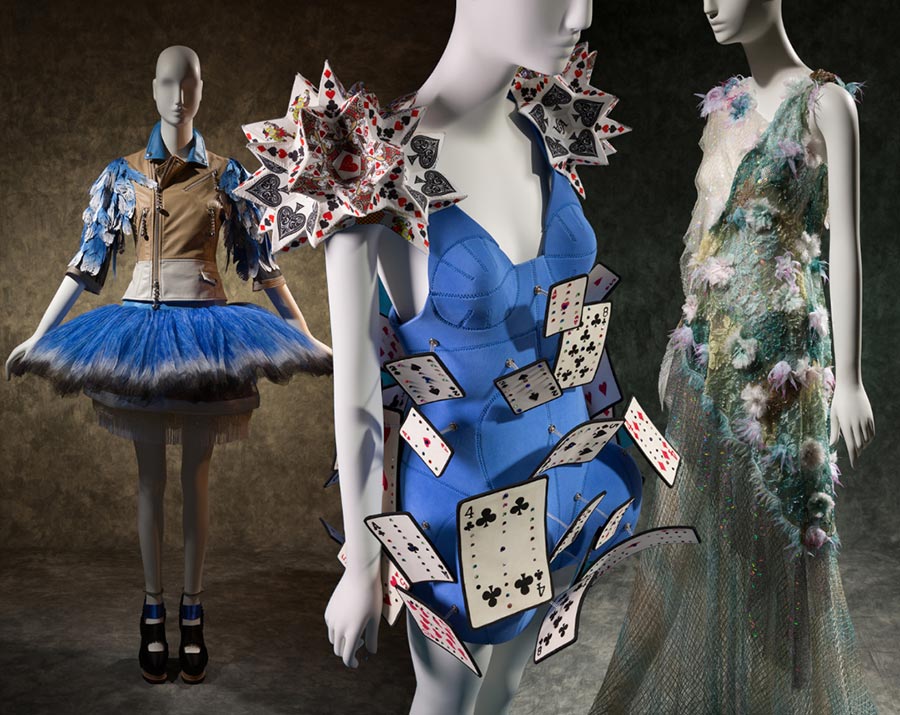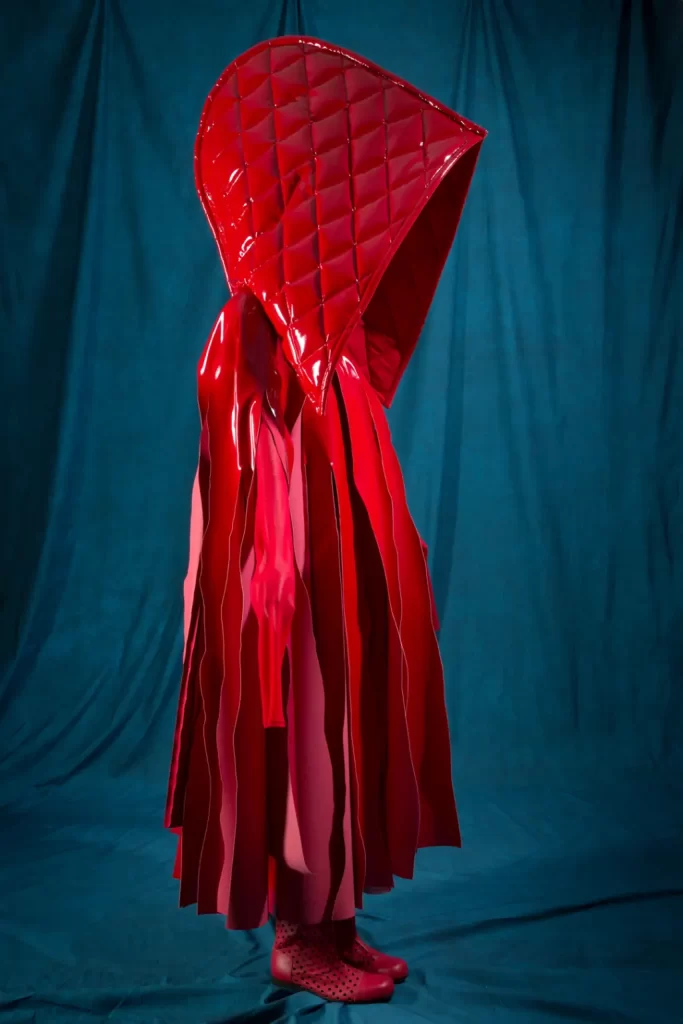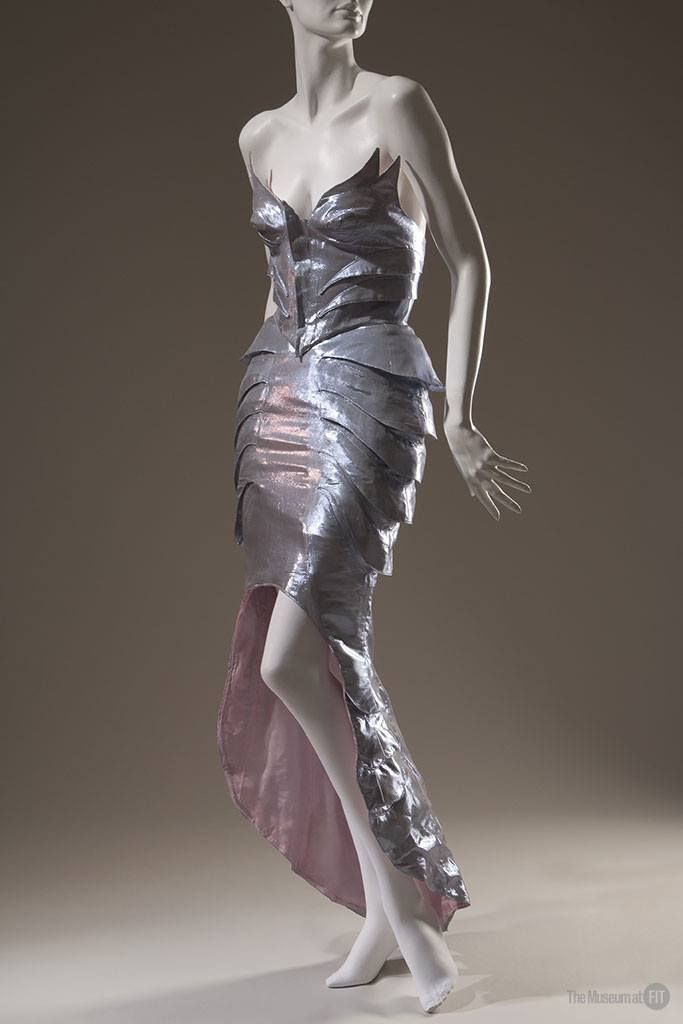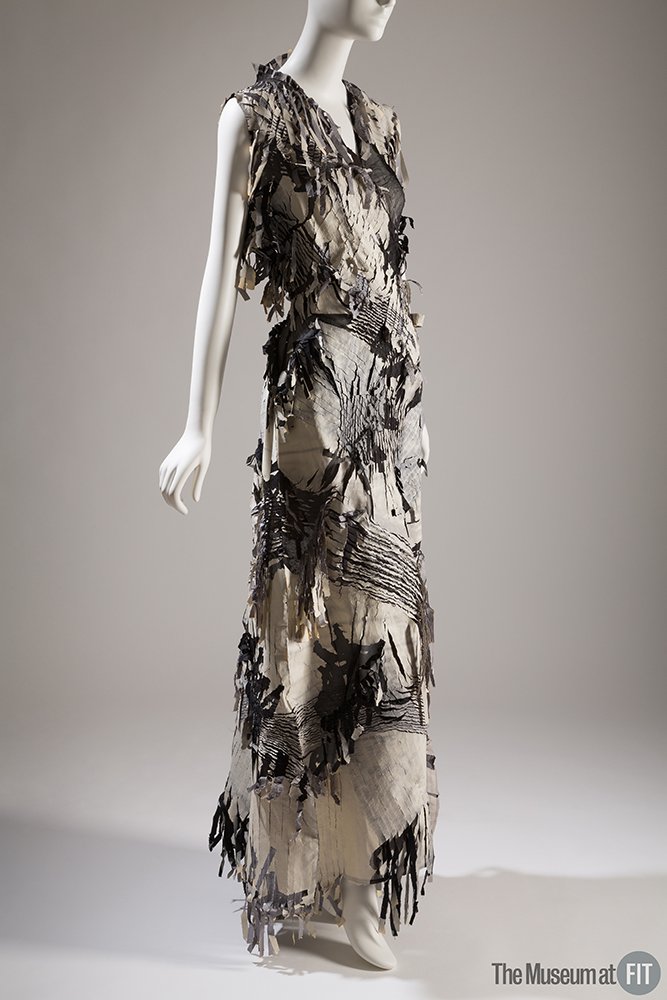
By Brendan Baehr
Throughout history, the world of high fashion has fixed its eyes upon source material of great influence and scope to inspire runway collections, both in terms of storytelling and aesthetic. It is no mistake that the greatest of these runway shows find their inspiration in the world of fairy tales, the root of all storytelling. The universal nature of these tales allows for their fashion counterparts to evoke emotion across countless groups of people, inspiring sentiment through a vastly shared body of knowledge. In examining the way modern couture on the fashion runway has taken influence from traditional fairy tales, it would be difficult to miss the oftentimes altered representation of the dresses and clothes of women within these tales. On the runway, these characters are retold in a far more empowering and independent approach, through the use of color, texture, and shape. The exhibit “Fairy Tale Fashion” at FIT is a clear demonstration of this interpretation, showcasing runway pieces ranging from 1940 to 2016, encompassing a wide variety of styles. This exhibit demonstrates the contrast in representation of women between the world of the high fashion runway and the world of the traditional fairy tale, primarily along the lines of power, independence, and sexualization.
Charles Perrault’s renditions of these everlasting tales create a stark contrast against the runway environment, influenced by Perrault’s own personal background as a member of the court of Louis XIV, existing in the birthplace of haute couture, a world of luxurious silks and elaborate patterns. Perrault’s version of “Little Red Riding Hood” exemplifies the difference in the way in which one article of clothing can be interpreted when cross examined with high fashion, this particular article being the iconic red cloak. It is firstly interesting to note that “It is likely that Perrault started the tradition of the iconic red cape”, and that “Early tellings do not describe her hood as being red”, as stated in an analysis provided by Ahlstrom Appraisals. The color red was chosen by Perrault likely as a result of the world of couture he surrounded himself with, in which red was a key signifier of nobility and purity. this choice is a notable one as it defines red riding hood as a character of vulnerable sexuality and danger. In Clothing The Child in Red, an analysis of this cloak states that “the little girl always wears the color red with a protective and salvific function”, and that in the time it was written, “children had always been dressed in red to make them more readily visible from afar”. This vision by Perrault of red riding hood as a symbol of untouched sexuality, only transgressed by the wolf, is a direct contrast to the way in which both Rei Kawakubo and Giorgio di Sant’Angelo envisioned red riding hood on the runway, instead turning her scarlet fervor into a symbol of power and strength.

In Comme Des Garçon’s 2015 Spring/Summer collection, Kawakubo placed the character of red riding hood front and center on the catwalk, with a magnificent red dress that flows over the body in layers of crimson, with an incredibly pointed and enveloping hood, fully covering the model’s figure. The gloss of the hood feels impenetrable, casting the model’s face into a foreboding shadow as their cloak enwraps their silhouette. The choice of a glossy and waterproof material for the hood of the cloak reimagines Red Riding Hood’s character as being prepared for the dangers of the world outside, stepping firmly away from the thin cotton hood that Perrault prescribed her. A simple change in material and grandeur transforms red riding hood’s cloak from a symbol of vulnerable sexuality to that of sexual strength and protection, stating outwardly to the environment that she is armed to defend herself against worldly disasters and pitfalls.

An equally contrasting yet visually opposite parallel to Rei’s rendition of red riding hood is that of the work of Giorgio di Sant’Angelo, who enacted upon this tale his personal vision of women’s couture, stated as being “committed to an uncomplicated notion of freedom, eschewing the shift dress with zippers and buttons, and designing fluid, sensual garments that wrapped, tied, hung or clung to the body” as stated in a background from the CFDA. This influence is clear in Sant’Angelo’s version of red riding hood’s cloak as displayed by FIT, flowing down the body in a dark crimson, with bright and multicolored stitching outlining the hem of the hood, and crisscrossing the chest in the form of an X. This explosive freedom in color allows the dress to incite the feeling of strength and confidence when viewed, specifically when placed across the body in the form of a protective X, sealing the wearer’s innocence in a form of creative power, rather than a naïve vulnerability as portrayed by Perrault. Both the work of Rei Kawakubo and Giorgio di Sant’Angelo work in unison in this exhibit, each building on a vision of red riding hood as a source of sexual impenetrability and protection to break away from the victimizing and degradingly vulnerable image that Perrault defined in his original rendition of the tale.
Hans Christian Andersen’s tale of “The Little Mermaid” is one placed in equal contrast within the dresses on display at the “Fairy Tale Fashion” exhibit at FIT, specifically through the work of Thierry Mugler in 1988. Andersen’s tale describes the character of the little mermaid as one of strong and powerful desire, both for the man above the surface and for the possibility of obtaining a soul. This desire is exemplified through the little mermaid’s physical appearance in Andersen’s tale, as she is only able to reach an initial success in her quest of living above the sea when she abandons a significant portion of her body and the form of the mermaid, taking instead the form of the human. Once she reaches the surface, the prince takes her naked figure to safety and cloaks her in the finest silks and fabrics available, and at only this point is her character found to be in a situation of admiration and love from all around her. Andersen formulates his tale around the importance that the little mermaid places on physicality and physical validation, defining this validation as only attainable when she conforms to the body, clothing, and silhouette deemed beautiful by the rest of the world.

As displayed at FIT, Thierry Mugler instead grants the little mermaid this power and grandeur through the form of her true self, crossing the catwalk in a cast of glistening silver, edges protruding like scales down the entirety of the dress in a way evocative of a knight in shining armor. The dress splits at the point of the wearer’s knees in the same way a fishtail would, embracing a tightly fitting silhouette reminiscent of a mermaid while still defining itself as aggressive and domineering. Mugler’s work with this dress reimagines the little mermaid not as a victim or compliant of the will of man and a man’s world, but instead as a weapon, armed to the teeth with the sharpness and beauty that ancient seamen’s tales had foretold. The terrifying beauty of this dress shines an even greater emphasis on the demeaning undertones in Andersen’s original tale, which strictly restrains the prince from ever witnessing the little mermaid in her true and powerful form, with him only finding her at her weakest, in a fully nude state. While Andersen’s tale of the little mermaid is unable to break away from its lack of exemplified feminine power, the work of Thierry Mugler seeks to both reimagine and bring attention to this absence, clothing the little mermaid in her own form, but giving her the sharpness and glamour within this form that Andersen constricts to granting only when she is dressed in the clothing of her oppressors.
This discrepancy between fairy tales and the world of high fashion is especially evident in the most fashion-oriented tale, “Cinderella”. In the version of this tale by the Brothers Grimm, clothing is the driving force for Cinderella’s character, constricting her to her housekeeper status, or alternatively, granting her a dance with the prince. Only through wearing the gown deemed beautiful by the world of the nobles is Cinderella able to find happiness, highlighting how the only path to success in this world is to embrace the standard of beauty as established by the patriarchy.

To reimagine the way Cinderella’s shift in clothing relates to her portrayal and treatment, Yoshiki Hishinuma emblazoned a dress of coarse ash and fiery tatters on the runway of his Fall 2001 collection, reframing the way in which her rags are viewed. The dress falls gracefully along the wearer’s body, using its constantly shifting texture to show detail and care in the dress’s design, created through a process of heat compression and tearing by hand. Hishinuma empowers the character of Cinderella in her determined “weakest” state by the Brothers Grimm, portraying her commanding rise from the ashes that constrain her.

In contrast to this dress, Vivienne Westwood’s Fall 1988 collection embraces the character of Cinderella in her moment of stepping foot onto the ballroom floor, clad in a dress of silver and silk. While this dress does capture the same level of craftsmanship that is implied in the Brothers Grimm vision, it immensely tones down the levels of grandeur and extravagance stated in the Grimm’s tale. By choosing to embrace the general form of the luxurious ball gown but remove all the frills and excessive splendor, Vivienne Westwood grasps the power of the patriarchy and restores it to Cinderella herself, a character able to adopt and then subvert the norms in women’s’ fashion deemed attractive by the patriarchy. The tale of Cinderella itself is a clear statement on how women should dress and act if they want to reap the benefits offered by their oppressors, and as stated in Fashion in the Fairy Tale Tradition: What Cinderella Wore, this tale exemplifies the “powerful political forces that have bound the status of women within layers of fabric, under the weight of gemstones, and upon teetering heels”. Cinderella’s ability to transcend this culture of misogyny through each of these dresses displayed at FIT brings great attention to the weight the patriarchy holds in the Brothers Grimm’s “Cinderella”, and the subsequent weight that can be lifted through simply a reimagining of dress.
The way in which the world of high fashion has continued to draw inspiration from the world of fairy tales is indicative of the versatile and everlasting nature these tales possess, but it is equally important in its intention to reimagine these tales and bring voices to the female protagonists so often constrained by their assigned attire. Whether written by Perrault, Hans Christian Andersen, or the Brothers Grimm, nearly all fairy tales with female protagonists use clothing to repress or make vulnerable the women wearing them, or alternatively give them strength when the clothing matches what the patriarchy demands of them, only then granting a “happy ending”. The collection of dresses on display in FIT’s exhibit “Fairy Tale Fashion” each tackle the nuances of this misogyny through the work of designers ranging from the vibrant 70’s inspired Giorgio di Sant’Angelo to the powerfully sleek work of Thierry Mugler, each piece uniquely reimagining the oppressive and constrictive nature imposed by their original renditions in order to create a true “happily ever after” for the likes of red riding hood, the little mermaid, and Cinderella, without conforming to the patriarchal values that surround them.
Bibliography
Andersen, Hans Christian. “The Little Mermaid.” The Classic Fairy Tales: Texts, Criticism, edited by Maria Tatar, W.W. Norton Et Company, New York ; London, 2017, pp. 351-371.
Perrault, Charles. “Little Red Riding Hood.” The Classic Fairy Tales: Texts, Criticism, edited by Maria Tatar, W.W. Norton Et Company, New York ; London, 2017, pp. 42-44.
Grimm, Jacob and Wilhelm. “Cinderella.” The Classic Fairy Tales: Texts, Criticism, edited by Maria Tatar, W.W. Norton Et Company, New York ; London, 2017, pp. 195-201.
The Museum at FIT. “Fairy Tale Fashion.” https://exhibitions.fitnyc.edu/fairy-tale-fashion/?url=cinderella%2Fcinderella_yoshiki_hishinuma-1
Christy, C. A. (2022, January 14). “Little Red Riding Hood” – a tale of 18th century fashion? Ahlstrom Appraisals LLC. Retrieved from https://ahlstromappraisals.com/art-history-blog/little-red-riding-hood-a-tale-of-18th-century-fashion
Singh, R. (2017, August 18) “Fashion Flashback: Giorgio Di Sant’Angelo.” CFDA, https://cfda.com/news/fashion-flashback-giorgio-di-santangelo
Rozario, Rebecca-Anne C. Do. Fashion in the Fairy Tale Tradition : What Cinderella Wore / Rebecca-Anne C. Do Rozario. 2018. Print.